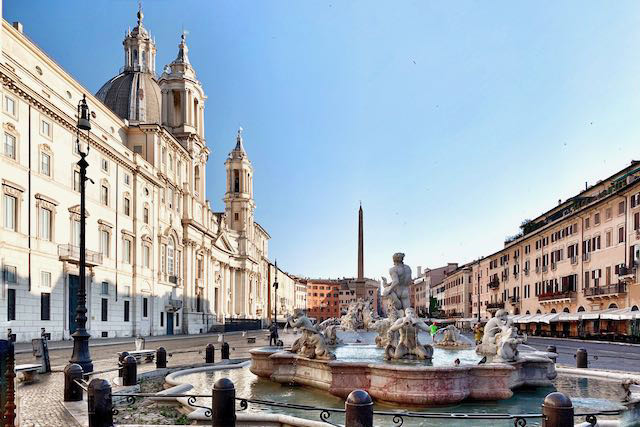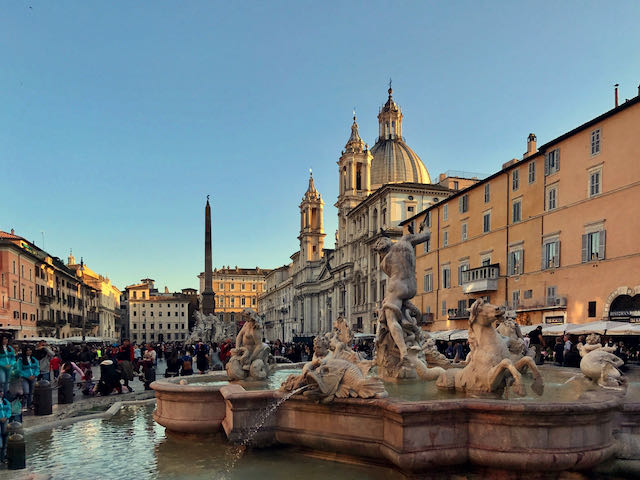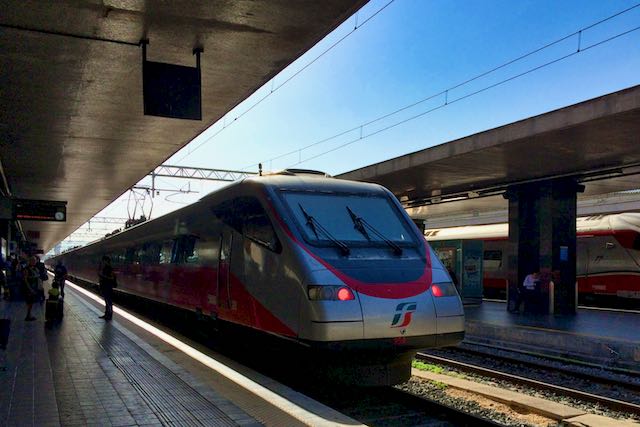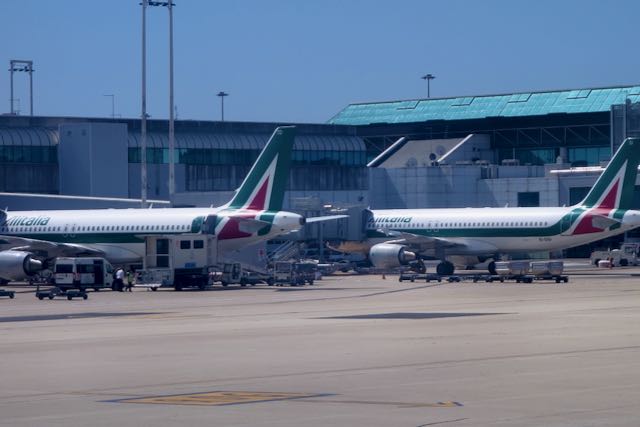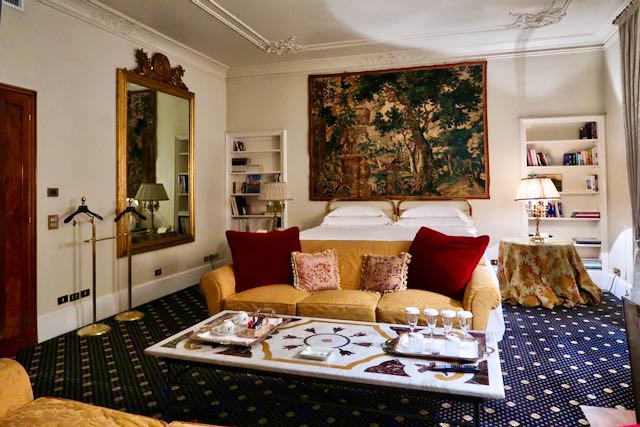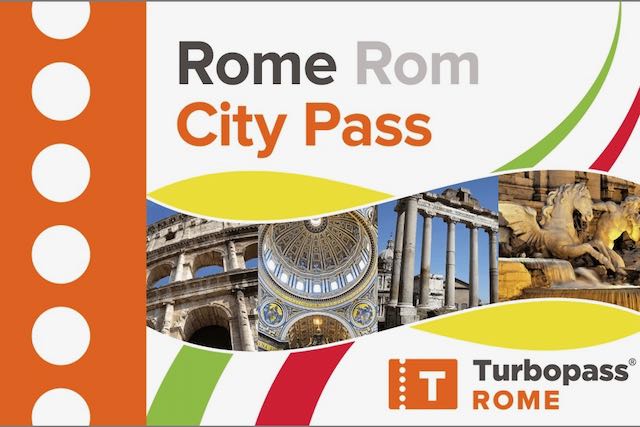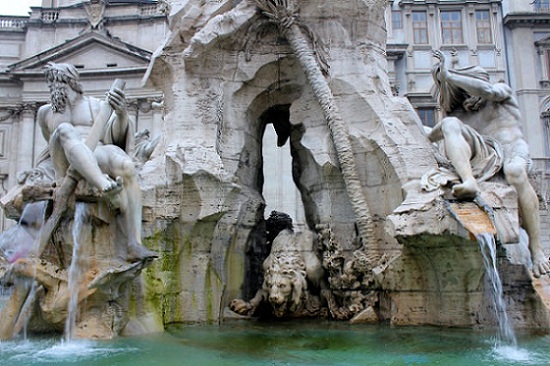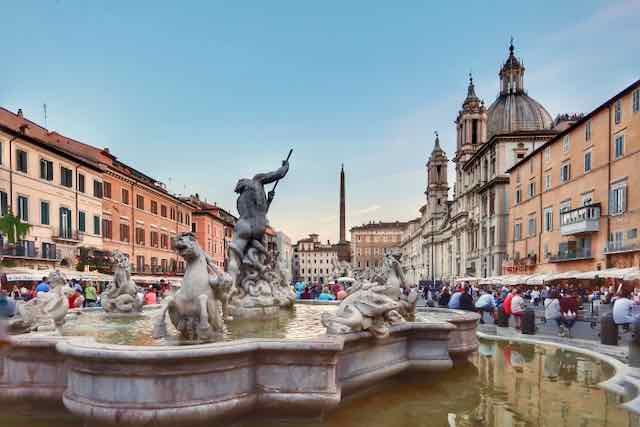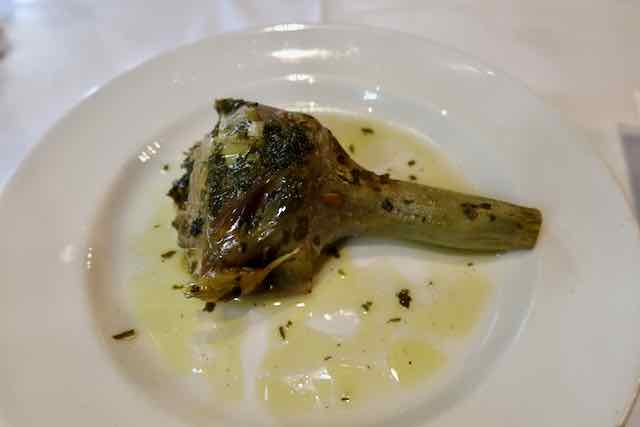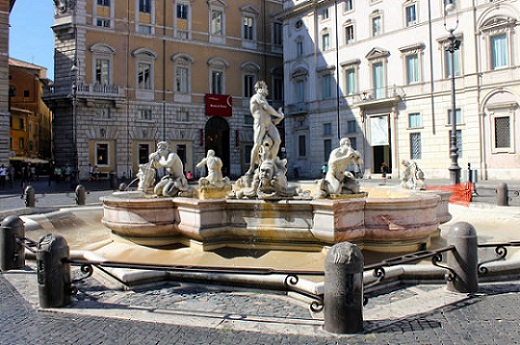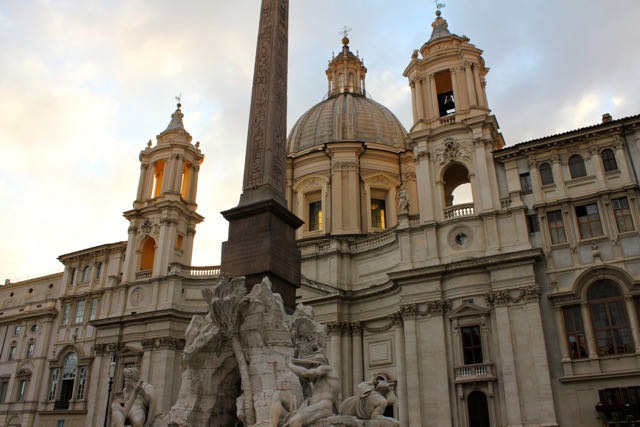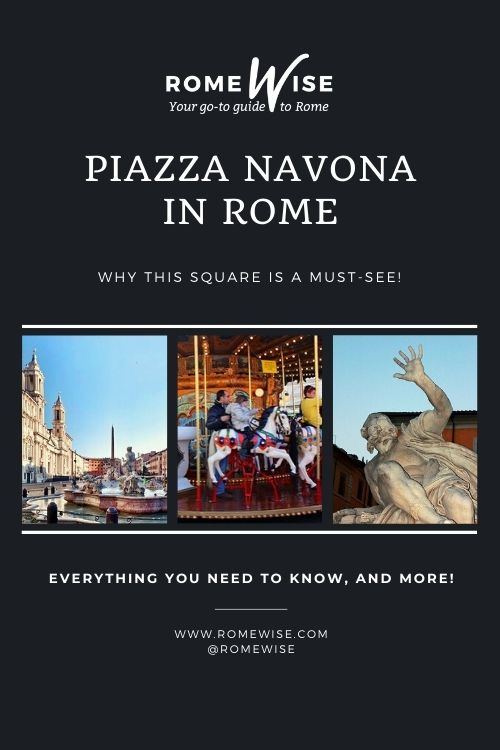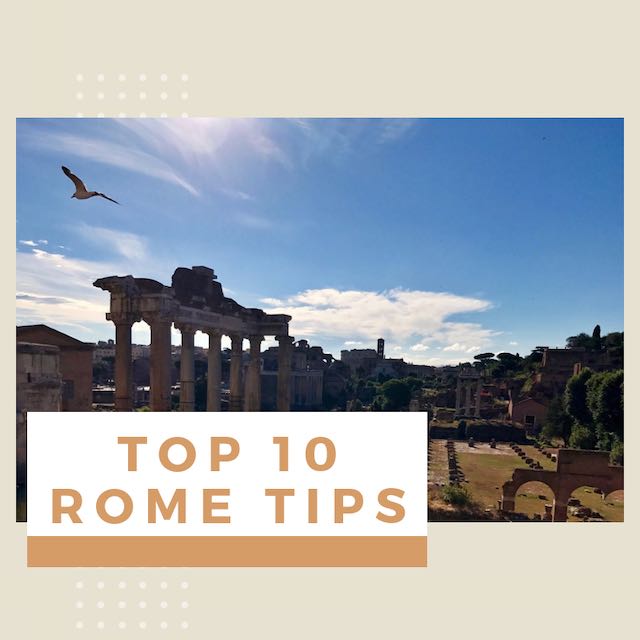- Sign up & get a FREE ebook Subscribe Today!
- Romewise Home Page
- Rome Tourist Attractions
- Piazza Navona Rome
Piazza Navona Rome
Why this square is a Must-See!
Piazza Navona Rome is arguably its most beautiful baroque square.
Don't miss visiting this gorgeous plaza and its breathtaking Bernini fountain.
I never cease to be impressed by the beautiful fountains and baroque architecture all along Piazza Navona in Rome. But there is so much more to it than meets the eye!
Cool things to know about Piazza Navona in Rome
Did you know…
- Piazza Navona used to be a stadium in ancient Rome? And they used to flood it and hold naval war-games there?
- One woman was almost entirely responsible for much of the most stunning baroque architecture you see on this square?
- A famous ghost shows her hand at every full moon?
- Gianlorenzo Bernini, one of the most famous architects of his day, designed the fountain in the middle. But he almost didn’t!
- Piazza Navona is the epicentre of Christmas in Rome?
Piazza Navona Rome – once a glorious stadium
If you look at a map of Rome today, you can see that the shape of Piazza Navona is something like a large, oval-shaped stadium. And that’s just what it was in Ancient Rome.
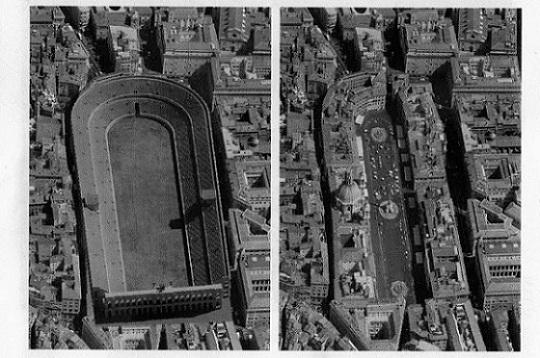 This image shows you how precisely the shape of modern-day Piazza Navona follows the shape of the ancient Roman stadium!
This image shows you how precisely the shape of modern-day Piazza Navona follows the shape of the ancient Roman stadium!Emperor Domitian had the stadium built in 86 AD. It was called the “Circus Agonalis” – from the Greek “agones”, or contest. The stadium could hold up to 30,000 spectators (about half as many as the Colosseum.)
It was used for all kinds of games, including nude Greek athletic contests.
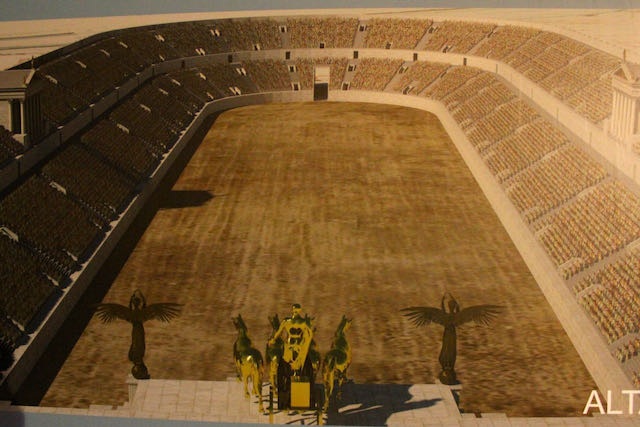 Piazza Navona at the time of the emperor Domitian - the first stadium dedicated to competitive athletics
Piazza Navona at the time of the emperor Domitian - the first stadium dedicated to competitive athleticsSometimes, they would even flood the stadium and hold mock naval battles there. (Once, they used it for gladiator matches when the Coliseum was hit by lightening in the 3rd century.)
The name “Navona” may have come from an evolution of the original name “in Agone” to “Navone.” Or, it may be because “Navona” means big ship, referring to the mock naval battles held there.
Visiting the ruins of the original stadium
If you like, you can even go see some remnants of the original stadium, "Stadio Domiziano." At the northern end of Piazza Navona, on Piazza di Tor Sanguigna, you can look down and see some of the original structure.
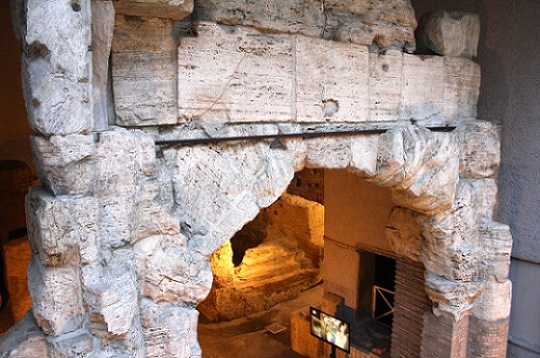 Street view of the ruins of the stadium
Street view of the ruins of the stadium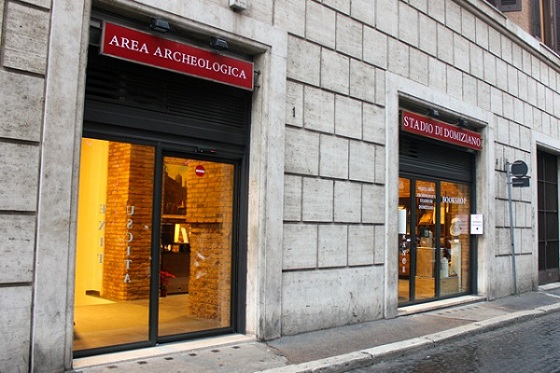 Entrance to the underground ruins
Entrance to the underground ruinsYou can also get a deeper insight by visiting these ruins.
Entry is under 10 Euros, and the visit won’t take too long. You can also take a guided tour.
In fact, it's pretty interesting because there is a lot of info down there, not just about the stadium but about other ancient Roman monuments and structures as well.
And, as a nice bonus, there is a clean, well-kept bathroom there too!
Piazza Navona in the Renaissance Period
During the Middle Ages in Rome, people were poor and desperate, and did not have a strong appreciation for the ancient structures around them.
They pilfered most of the crumbling buildings to take the stones for their own use, which is one reason we often see only remnants today (even the Coliseum was taken apart to build other structures in Rome, including Saint Peters Basilica.)
The stadium of Domitian also fell victim to this kind of destruction. And so eventually this left a huge open space.
In the early Renaissance, the stadium was paved over, and Piazza Navona was created.
Beginning in the late 1400’s, Piazza Navona was the site of the main outdoor fruit and vegetable markets of the city. (In 1869, the market was moved to Campo dei Fiori.)
In the Renaissance years, Piazza Navona was also still used for festivals, smaller games and, was even flooded on Saturdays and Sundays in summer, so the Romans could have a place to cool off (they just turned off the drainage system of the 3 fountains, and voilà! A flood!)
After 1870, (the reunification of Italy), the square was paved with the typical cobblestones you see around Rome today (called sampietrini) which made the piazza convex.
So, even if we wanted stop the fountains from draining today, as they did back then, it would be impossible to flood Piazza Navona any more.
Piazza Navona and Pope Innocent X
In the mid 1500’s, soon after Piazza Navona was paved over and began being used as a market and plaza, Pope Gregory XIII (he of Gregorian calendar fame, from the Boncompagni family) had three small fountains placed in the plaza.
They were not yet the beautiful fountains you see today.
Almost a century later, Pope Urban VIII (from the Barberini family) began furiously building palaces and monuments all over Rome, to seal his long (20-year) legacy.
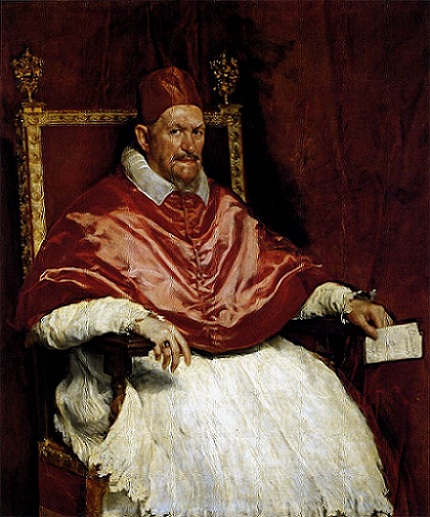 Portrait of Pope Innocent X
Portrait of Pope Innocent XA portrait of Pope Innocent X, as painted by the Spanish artist Diego Velázquez.
You can see this painting up close inside the wonderful and under-visited Galleria Doria Pamphilj.
After Urban VIII died in 1644, Pope Innocent X (from the Pamphilj family) took office.
He had a big chip on his shoulder about the Barberinis, which included the previous pope.
So he decided to furiously build things in Rome as well, for his own legacy. In fact, he had many things torn down so he could create a more impressive version.
Here is the part where it gets a little sticky.
Pope Innocent X did want to leave his mark on Rome.
But what he had done on Piazza Navona, why, how and by whom, well that is another story.
Donna Olimpia Maidalchini - "La Pimpaccia"
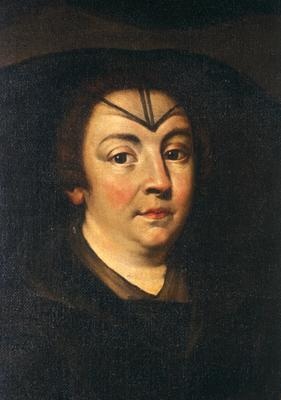 Portrait of Donna Olimpia Maidalchini
Portrait of Donna Olimpia MaidalchiniSo now it’s time to tell you the story of Donna Olimpia Maidalchini, and more specifically, her influence on the architecture of Piazza Navona.
From a very young age, she began her social climbing activities.
Originally from a modest family from Viterbo (not far from Rome), the pretty and sharp Olimpia married a wealthy young man, who promptly died shortly thereafter.
Now, armed with her own wealth, Olimpia sought more power and prestige, and she set her sights on, and won, the heart of the nobleman Pamphilio Pamphilj, thirty years her senior.
As it turns out, Pamphilio’s brother, Giambattista Pamphilj, was cardinal and favorite to become pope.
Olimpia became very “close” to Giambattista, and began to influence (almost) his every move.
Now when I say “close”, I mean there were rumors, but no proof, of more closeness than one would expect from a pope and his sister-in-law.
Some sources swear there was an intimate relationship between them, and other historians have negated this claim.
Read on, and decide what you’d like to believe.
Donna Olimpia Maidalchini was very ambitious, and money, power and prestige meant a lot to her.
She aspired to what we’d call today “conspicuous consumption” and demanded of her brother in law that she and her husband have a palace befitting their stature.
Thus, Pope Innocent X (Pamphilj), decided to replace a building that was on their land (which was smack on Piazza Navona in Rome), with a new palace that would be much more grand.
And that is where Olimpia lived even after her husband Pamphilio died.
This amazing palace we see today, Palazzo Pamphilj (which is now the home of the Brazilian embassy) was built by one of the best architects of the time, Girolamo Rainaldi.
On occasion it's possible to take a guided tour of the Palazzo Pamphilj, and it is magnificent. Here are a couple of photos from inside:
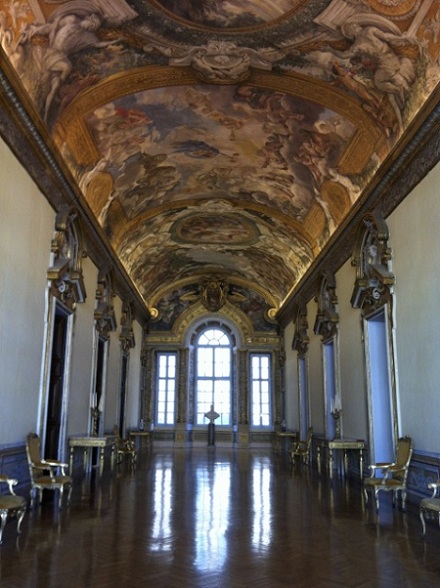 Borromini's gallery inside the Palazzo Pamphilj.
Borromini's gallery inside the Palazzo Pamphilj.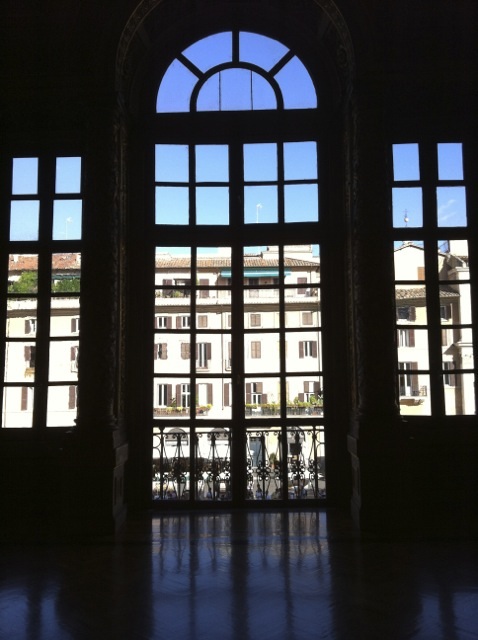 View of Piazza Navona from inside the Palazzo Pamphilj.
View of Piazza Navona from inside the Palazzo Pamphilj.Olimpia was not a popular woman.
The Roman population did not like her and her shameless greed and power mongering.
She was nicknamed “La Pimpaccia”, which is a pretty unflattering word.
The perfect 3-day itinerary in Rome
Trying to figure out how to organize your visit to Rome? I've got the perfect 3-day itinerary for first-time visitors (or those who have not been here in a while.) It works for a 2.5 day visit as well.
In my 3-day itinerary, you'll see all the major must-see Rome attractions like the Vatican, Colosseum, Trevi Fountain, Pantheon, Piazza Navona, Spanish Steps, Castel Sant'Angelo, and much more.
And if you have more time, or want suggestions for extra/other things to do, you'll find that there too.
Visit my page with the best 3-day itinerary in Rome for first-timers.
Piazza Navona Rome and The Four Rivers Fountain
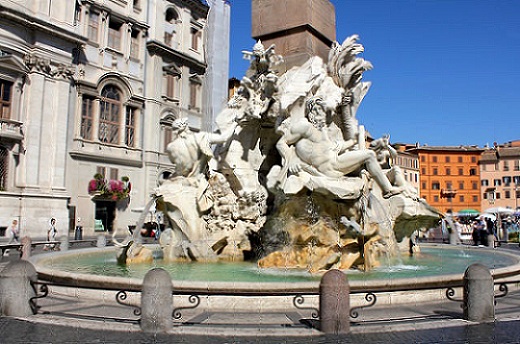 Piazza Navona. Fountain of the Four Rivers. Decorative sculpture and Baroque masterpiece of Gianlorenzo Bernini
Piazza Navona. Fountain of the Four Rivers. Decorative sculpture and Baroque masterpiece of Gianlorenzo BerniniThe Four Rivers Fountain, one of Bernini's most spectacular masterpieces in Rome, stands right in the center of Piazza Navona Rome.
But it very nearly didn't happen.
Even in the 1600's, there was plenty of intrigue, petty jealousy and rivalry to go around.
Pope Innocent X's "confidante", Olimpia Maidalchini (see above) declared that Navona square would need much more spectacular fountains.
There was talk of giving this commission to the talented architect, and favorite of the pope, Francesco Borromini.
No matter what season you visit Rome, here are 4 things never to leave at home:
Disclosure: If you make a purchase through a link on this page, I may receive a small commission - at no extra cost to you. Thank you for supporting my site!
In fact, Innocent X specifically disliked Borromini’s rival, Gianlorenzo Bernini, because Bernini had been the protégé and favorite of the previous pope, Urban VIII, who Innocent X couldn’t stand. (In addition, Bernini’s reputation had recently been ruined by the scandal of the bell towers at the Vatican, but that is another story.)
So initially, the pope flat out refused to let Bernini even be a contender to make the central fountain.
But Bernini was no slouch himself.
He knew what he had to do, and whose influence he needed to win: he had a silver model of his idea for the fountain sent to Olimpia.
She loved it, and showed her brother in law, the pope, who decided Bernini should design the fountain after all.
Isn’t that lucky for the rest of us?
That fountain, constructed between 1647 and 1651, is the fountain you see in the middle of Piazza Navona Rome.
It’s called The Four Rivers Fountain, or “La Fontana dei Quattro Fiumi.”
The four rivers referred to the most known rivers of the four corners of world at that time: The Danube (Europe), the Nile (Africa), the Ganghes (India) and Rio de la Plata (Americas.)
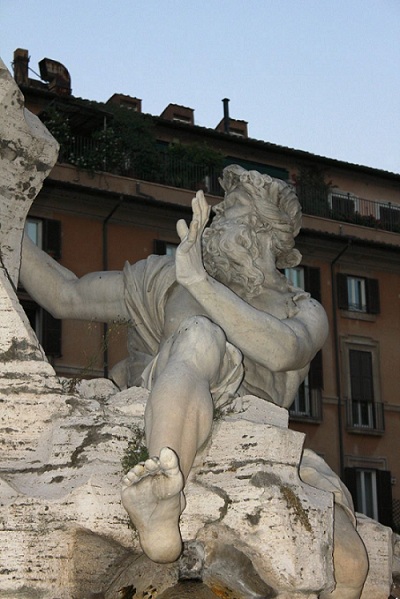 Danube
Danube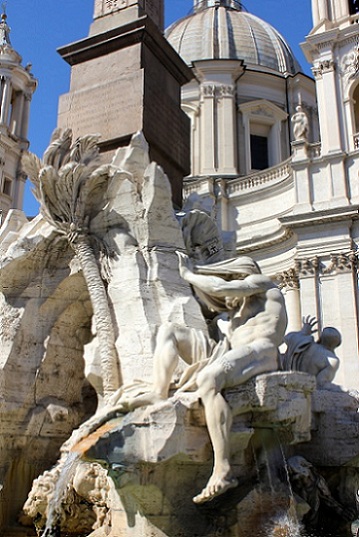 Nile
Nile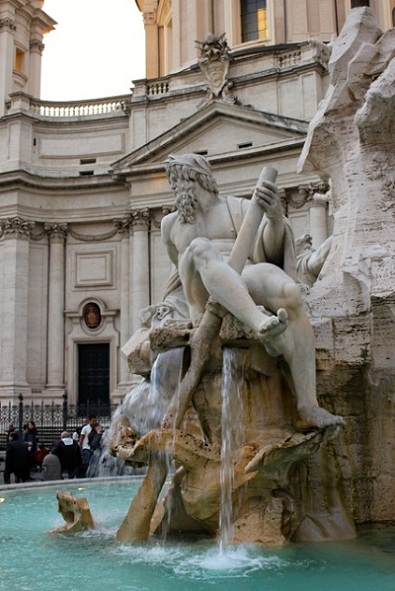 Ganges
Ganges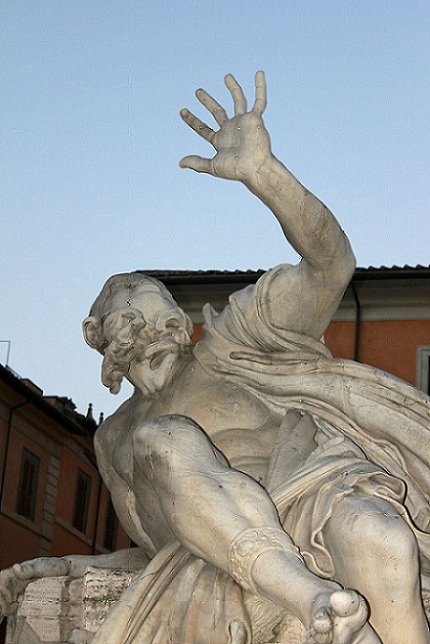 Rio della Plata
Rio della PlataThere is a cute myth that Romans like to tell visitors to Rome, but it’s not true: They say that when Bernini made his fountain, he aimed to show contempt for his rival Borromini.
If you look at the statue of the Rio de la Plata, you can see his arm raised to protect its head, as if to say, oh this hideous building (Borromini’s church, right in front of him), is going to crumble.
Also, the Nile River has a veil over his face.
The story goes that this is because Borromini's church was too hideous to look at.
Well, the veil in fact symbolized how little was known about the Nile at the time.
In any case, these little stories not only untrue but impossible.
Borromini started to design his church a few years after Bernini finished his fountain.
One more cool fact about this fountain:
The design of a very heavy obelisk (originally found in Massenzio Circus) standing on a hollowed out base was anathema to the thinking of the time.
Everyone assumed it couldn’t be done, that the structure would not hold the weight.
But Gianlorenzo’s brother, Luigi Bernini, was a brilliant engineer and mathematician and it was he who helped provide the calculations and the main blueprint for this design.
Gianlorenzo Bernini was indeed a genius but he had a little help.
The other two fountains on Piazza Navona Rome
The two other fountains on Piazza Navona Rome are the Fontana del Nettuno (Neptune fountain) at the northern end and the Fontana del Moro (Moor fountain) at the southern end.
Both were created by Giacomo della Porta (the fountains but not the sculptures in the middle of each.)
Bernini seemed to have finally gotten in the good graces of Pope Innocent X, and in 1653 the pope asked Bernini to add a sculpture to the fountain on the south end.
Bernini designed a man standing on a shell, holding a dolphin by its tail; Somehow the man’s face came out looking a bit Arabic, and the statue and in fact the whole fountain were nicknamed “il Moro”, or the Moor.
In the 19th century, tritons were added to this fountain.
The Fontana del Nettuno, at the north end, was built in 1574.
The statues of Neptune and the surrounding sea nymphs were added in the 19th century, to make the piazza more symmetrical, i.e. to make this fountain more or less similar in size and scope to the Moor fountain.
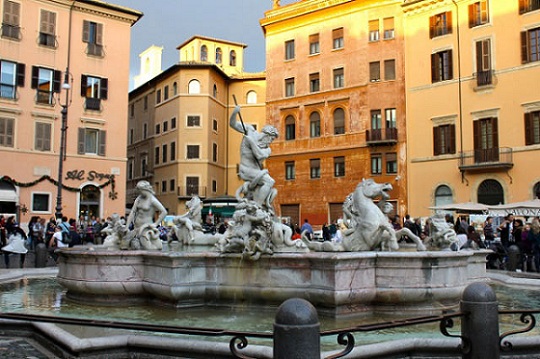 The Fountain of Neptune. It was only completed in the 19th century with the sculptures of Neptune and other mythological figures
The Fountain of Neptune. It was only completed in the 19th century with the sculptures of Neptune and other mythological figuresPiazza Navona Rome and Sant'Agnese in Agone
Remember Olimpia, La Pimpaccia? Well, as her palatial home was being built, she also said, we really need a family chapel as well.
The two architects working most for the pope at that time were Rainaldi and Borromini. Both worked on the palazzo (Borromini built the gallery.)
The commission to build the family “chapel,” was initially assigned to Rainaldi and his son Carlo.
Then Borromini took over, and modified the design of the façade. Borromini’s design was very smart: he made the façade concave so that you could see the dome easily from below.
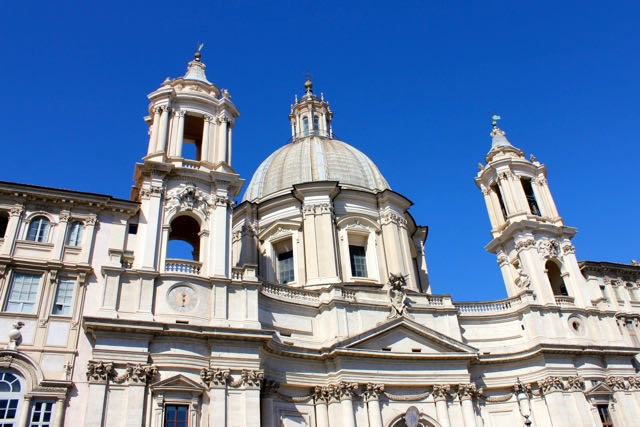 Saint Agnes in Agone. A corollary of architectural visions and power disputes
Saint Agnes in Agone. A corollary of architectural visions and power disputesAfter Pope Innocent X died, Borromini lost the commission once again, and the final design went back to Carlo Rainaldi, who kept most of what Borromini had designed anyway.
The church was completed in 1670.
This “family chapel”, is today known as the stunningly beautiful church of Sant’Agnese in Agone, which sits right in the middle of one side of Piazza Navona in Rome.
(The most ancient structure of the church dates back to the 8th century, so the current church is a remodel, several times over.)
The church is dedicated to Saint Agnes, right on the spot where two thousand years ago she was martyred.
Learn more about Bernini and Borromini's influence on Rome with this special tour!
The ghosts of Piazza Navona Rome
Last word about Donna Olimpia Maidalchini…and a kind of Rome ghost story: As I said, La Pimpaccia was detested by the Roman populace.
When Pope Innocent X was dying, she saw the writing on the wall, so to speak. While he was literally on his deathbed, Olimpia hid, finally stealing as many riches as she could from her own palazzo, and taking off in a carriage over the bridge known today as Ponte Sisto.
One sad note about this is that when Pope Innocent X died, neither she nor anyone in her family spent a penny on his burial.
After a few days with no burial whatsoever, Pope Innocent X was finally buried only because his butler helped pay for it.
Meanwhile, La Pimpaccia, banned from Rome by the new pope, Alexander VII, was exiled to her family home and died two years later from the plague.
They say her ghost rides the carriage across Ponte Sisto on January 7 (the anniversary of the death of Pope Innocent X.)
🤙 Roaming in Rome? 📱
Get yourself an Italian eSIM for calls, messages and data when traveling here.
Save on data charges with plans from just 19€ from Holafly - our recommended eSIM provider!
Click here to get yours now and use code ROMEWISE to save 5%!
Costanza de Cupis
Piazza Navona has another ghost as well, from about the same era.
In the 1600’s, a beautiful young noblewoman, Costanza de Cupis, lived in a palazzo on via dell’Anima. (The back of this palazzo, called Palazzo de Cupis, is on piazza Navona.)
Costanza de Cupis had lovely, alabaster hands. An artist once asked her if he could make a plaster model of them.
She consented, and he made a model that he placed in his shop.
A passerby saw the model, and made an ominous declaration: whoever these hands belongs to will lose them soon.
Costanza heard of this prediction and it terrified her.
So much that she refused to leave the house. But while she was sewing, she pricked a finger, and it eventually became infected.
Her hand was amputated in an attempt to save her but it was no use. Costanza, only in her early twenties, died of sepsis.
So the legend goes that on nights when there is a full moon, if you look up at the window of Palazzo de Cupis, just above the bar on via dell’Anima, you can see Costanza’s hand against the glass.
Piazza Navona Rome's Christmas Market and Fair
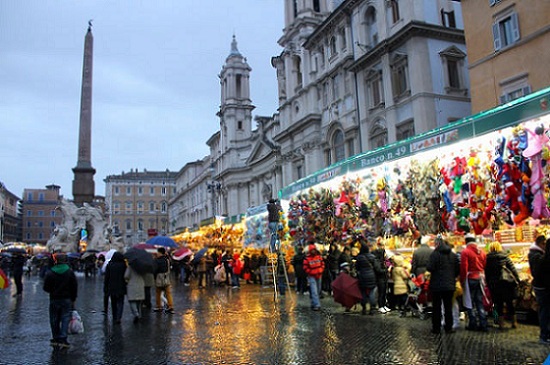 Piazza Navona during holidays hosts a classic Christmas set that embraces old traditions and radiates happiness.
Piazza Navona during holidays hosts a classic Christmas set that embraces old traditions and radiates happiness.When I first moved here, I would get kind of irritated by the traditional Christmas Markets held in Piazza Navona Rome.
The stands, carousel and nativity scene all went up on December 8 (La Immacolata, or Immaculate Conception), and didn't come down again until January 6 (The Epiphany, also called "La Befana".)
I couldn't wait until the plaza was restored to its beautiful emptiness so I could see the fountains and the majesty of the whole square again.
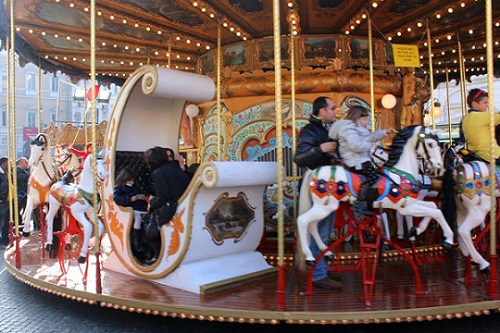 Christmas in Rome is a very magical time, and aside from its art and history, Piazza Navona embodies its true spirit
Christmas in Rome is a very magical time, and aside from its art and history, Piazza Navona embodies its true spiritThen my sister visited me with my (then) 5-year old niece.
My niece rode the carousel and had some cotton candy and hot chocolate (click here if you are looking for ideas for gifts in Rome).
I later found out that the carousel is one of the oldest functioning wooden rides in the world, built in Germany in 1896.
From then on, I understood: this Christmas Market harkens back to another time, and it's a lovely reminder of an old-fashioned traditional, family-style Italian Christmas in Rome.
And now, I cherish this time of year, and seeing the Christmas market in Piazza Navona. It's so festive, happy and warm, and it belongs there.
NB - As of 2014, the Christmas Market in Piazza Navona has gone through many changes. And in 2020 and 2021, we didn't have it at all, due to the Coronavirus pandemic. Stay tuned to see what future Christmases in Rome will bring!
Want to save this to Pinterest? Pin it here!
Get your 100% free Rome trip planner now!
Simply sign-up today for our free newsletter and get the Romewise Quick Start guide to Rome:
We are committed to respecting your data. Click for our Privacy Policy.
Comments? Questions? Suggestions?
Please come over to the private Romewise Facebook group and join in the conversation.
You will often find me there, happy to answer your questions / comments!
You will also meet other Rome lovers and experts, too.
What are you waiting for?
- Romewise Home Page
- Rome Tourist Attractions
- Piazza Navona Rome

